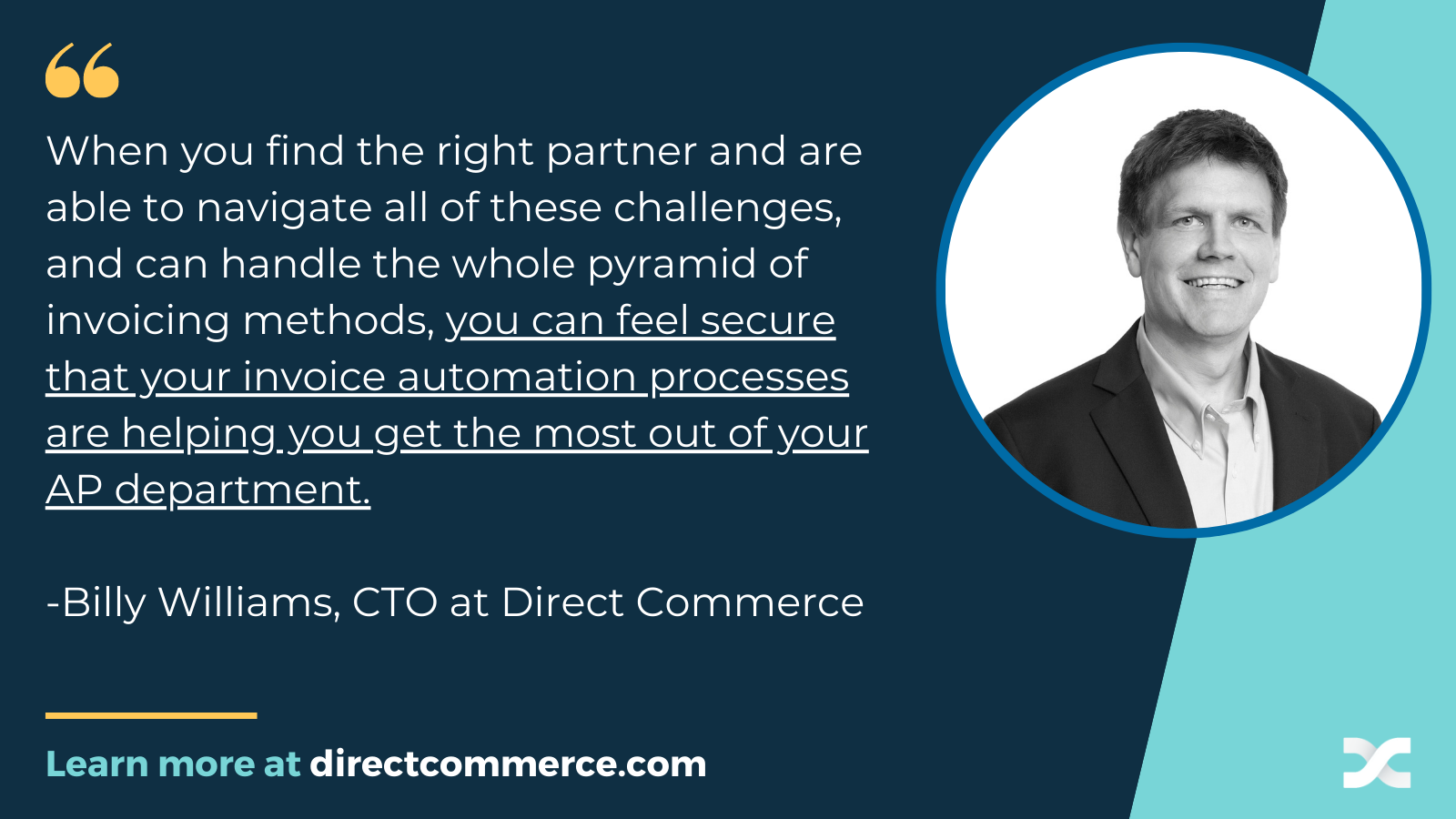To get the most out of your accounts payables processes, you need an invoice automation solution that can help you process invoices faster, reduce bad data, and cut costs. Find out what to look for in a new provider and what to expect if you’re looking for best-in-class invoice automation.
Continue below to read our full interview with Billy Williams, CTO of Direct Commerce. And if you’re starting your journey to digitally transform your invoice process, download our white paper on how to get started.
What Is 100% Invoice Automation?
Billy Williams: When I think about 100% invoice automation, we use a pyramid of invoices. At the top we have the high dollar value, high transaction volume, highly automated suppliers – like your EDI suppliers. The most important suppliers.
We work very intentionally with our clients’ most important suppliers to make sure they are able to onboard to our solution easily. And we have a real sweet spot in the middle, which is going to be what we call file-uploaders and portal users. I would even include email and paper coming in as well in this group.
And then at the very bottom, we handle some vendors who are still using procurement cards (P-cards), and we integrate that as well.
When I think 100%, it means we handle all of them. Certainly, one of the more difficult methods is the paper or PDFs coming in, which is where we integrate with image capture.
But that pyramid is a good way to look at the overall picture of 100% invoice capture and automation. The thing I like about it is that it shows the comprehensiveness. We're not just doing paper and electronic – we have file uploaders, P-cards, etc. Hopefully we can guide our customers towards the more efficient processes, highlight those paths that are less work for everybody and eliminate disputes, exceptions, and manual processing. But in the meantime, we can handle everything – paper, pdfs, electronic invoices, EDI, XML, and P-cards.
-png.png)
What Are the Benefits of 100% Invoice Automation?
BW: Our platform allows customers to process transactions much more easily than their existing tools and processes. All things are now digital to some degree. Our platform gives our customers the ability to say, “Hey, you know what? I have 80% of my transactions coming in through this automated method. Why don't I get 100%?”
There's a myth that suppliers will not do things electronically. There's a myth that you must keep your old process of sending a piece of paper or emailing a PDF. Suppliers don't want to do that. Suppliers want to get paid.
We’re talking to one company right now whose terms are net 120 with their suppliers. So what that means is that after you submit an invoice, you have to wait four months to see if it gets paid or not. What happens if four months later you get payment and it's wrong? For example, they didn't receive the goods or didn't like the service. In that case, the supplier would then email our client and tell them they got short paid, create a dispute, and then you’re going to wait another four months before repayment comes in.
With electronic invoicing, you will know almost immediately if your invoice has an exception or not. You would get informed that the terms aren’t correct, or you're referencing a purchase order that's been closed. Or you're referencing last year's purchase order. Don't expect to get paid on that. In fact, we'll show you an error message if you reference a bad PO.
On the contrary, if you stick with the old process, the postman delivers an invoice and it sits on somebody’s desk for 120 days before they do anything with it.
In general, whether it's paper, pdf, or electronic, we pull all data into a centralized repository. We give access to that information so everybody can see what those transactions are. You see all the related transactions. Even if an invoice came in via paper or PDF, you can still see it on our portal. You can see the associated purchase orders and payments. We have online tools as well that allow our clients and their suppliers to easily collaborate around those transactions. And then we also have additional facilities. If you have an invoice that's been submitted, we have things like our dynamic discounting module that will allow you to then get paid early on that invoice.
If that invoice happens to be electronic, like a true electronic invoice, then I think there's a much higher likelihood that you're going to get paid on time or you're going to get paid early.
Just getting the information out into a place where people can see it and access it for themselves prevents future problems. It answers questions. If you can go out and you can see the status of your invoices, your payments, your purchase orders, what the current values are, how they've changed – just getting information out in the open, I think that solves a lot of problems.
Risks of Manual Processes: Costs, Errors, and Inaccurate Financials
BW: You want timely and accurate capture of invoice information because ultimately it ends up with a payment going out to the vendor – it's real money. It is costly and tedious and a lot of work to process invoices.
Frankly, it's not just on the front-end. Certainly, front-end data entry is one of the steps of processing an invoice, but it's certainly not the only one. There's matching that goes along with that. Matching up invoices with PO numbers, making sure the information on the invoice is correct. Checks and balances in the process should prevent that. Corporate controls are an important thing. Our customers want to control spending. They want to have processes in place. Sarbanes-Oxley also comes into play – our customers need to understand their liabilities.
You don't want to have sloppy processes that lead to misleading information. For example, if I sent you a $1 million invoice and it's a piece of paper, it's going to float in the mail for a couple of days. It's going to sit on somebody's desk for a couple of days, and then it's probably going to be sitting in some queue. I've seen $100 million invoices, things that could have a material impact on your financial statements, that get put in front of the CFO for signature, and all of a sudden you find mistakes due to a sloppy AP department. They're losing invoices, they’re overpaying. It can certainly lead to much less confidence in your financial statements.
Key Challenges in Invoice Automation: Capture, Data Integration, and Change Management
BW: There are many challenges. One, on the front-end, just doing the heavy lifting of parsing what's written down on a printed document or in a PDF. That in itself is challenging.
I think once you get in and realize that it's possible to change people's behavior, that's not automatic either. And I think that’s one of the reasons why this myth persists that vendors won't do things electronically. I think it is possible, but it requires the right policies, procedures, and people. A lot of things have to be lined up for large scale change management to happen. And we talk a lot about how DCI helps make it happen in an interview with our VP of Customer Success.
I think people have tried to implement new software and new digital processes, and they've missed one or two elements along the way. Either they bought technology that didn't really work, or they bought good technology but their team didn't realize the strategy involved if you're going to change 10,000 suppliers’ behavior. Maybe you have a disorganized team, and they don't know who's using the system and who's not. Our team at Direct Commerce includes a team dedicated to helping our clients through this kind of change management, but that kind of service is rare.
I think there are a lot of pitfalls that people have fallen into and then they just damn the whole thing. They say “Well, we tried that. It didn't work.”
Old systems are challenges too. ERP systems are very large and very difficult to change. If an AP manager at a big company has an idea to implement an automation solution but it's going to require a change to the ERP system, forget it. All of our customers were extremely hamstrung with this. They can't make changes to their ERP systems. If they do, they box themselves into corners.
And I think that's one reason why they want to use the best provider like us, because we're really a bolt-on to their systems and processes. Our modules are composable and allow enterprise leaders to bring our best-in-class solutions into their composed IT environment. We are much more nimble and agile and we're really good at altering our platform. We have people available to make changes our customers need.
Lastly, another challenge is supplier satisfaction. I've heard some companies say it's very difficult for their procurement people to negotiate a better price with suppliers. If you have a stack of unpaid invoices sitting there, if you have problems in your accounts payable department, that makes supplier relationships much more strained.
Finding the Right Invoice Automation Partner
When you find the right partner and are able to navigate all of these challenges, and can handle the whole pyramid of invoicing methods, you can feel secure that your invoice automation processes are helping you get the most out of your AP department. Choosing your best partner means you’re choosing a provider that can meet these challenges AND integrate into your enterprise’s technology environment. At Direct Commerce it’s what we love - understanding our clients, getting to the heart of their business problem, overcoming challenges, and helping them achieve their most impactful outcomes.
Learn More
If you’re ready to experience best-in-class invoice automation, contact our team today. We’ll walk you through how our platform works and makes it easier for both you and your suppliers, streamlining your processes, reducing errors, and cutting costs.
Want to request more information or see a demo? Schedule a meeting with one of our invoice automation experts.
Make sure to grab these resources as you continue to drive toward invoice automation excellence:
- White Paper: Starting Your Journey to 100% Invoice Automation
- Blog: Invoice Automation – Making the Case for Transforming Your Process
- White Paper: The Business Case for AP Automation


